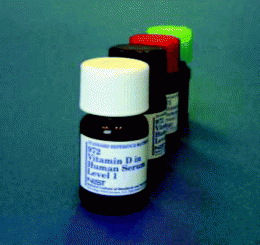New standard for vitamin D testing to ensure accurate test results

At a time of increasing concern about low vitamin D levels in the world's population and increased use of blood tests for the vitamin, scientists are reporting development of a much-needed reference material to assure that measurements of vitamin D levels are accurate. The report appears in ACS' journal Analytical Chemistry.
Karen Phinney and colleagues explain that medical research suggests vitamin D deficiency or insufficiency may be even more common than previously thought and a risk factor for more than just bone diseases. An estimated 50-75 percent of people in the U.S. may not have enough vitamin D in their bodies. Low levels of vitamin D have been linked to the development of several conditions, including rickets (soft and deformed bones), osteoporosis, some cancers, multiple sclerosis and Parkinson's disease. People can make their own vitamin D simply by rolling up their shirt sleeves and exposing their skin to sunlight. But for those cooped up in offices all day long, food and dietary supplements also can provide vitamin D. With this renewed interest in vitamin D, scientists need an accurate way to measure its levels in the blood. Measuring vitamin D itself doesn't work because it is rapidly changed into another form in the liver. That's why current methods detect levels of a vitamin D metabolite called 25(OH)D. However, the test methods don't always agree and produce different results. To help laboratories come up with consistent and accurate methods, the researchers developed a Standard Reference Material called SRM 972, the first certified reference material for the determination of the metabolite in human serum (a component of blood).
The researchers developed four versions of the standard, with different levels of the vitamin D metabolites 25(OH)D2 and 25(OH)D3 in human serum. They also determined the levels of 3-epi-25(OH)D in the adult human serum samples. Surprisingly, they found that this metabolite — previously thought to only exist in the blood of infants — was present in adult serum. "This reference material provides a mechanism to ensure measurement accuracy and comparability and represents a first step toward standardization of 25(OH)D measurements," say the researchers.
More information: Development and Certification of a Standard Reference Material for Vitamin D Metabolites in Human Serum, Anal. Chem., 2012, 84 (2), pp 956–962. DOI: 10.1021/ac202047n
Abstract
The National Institute of Standards and Technology (NIST), in collaboration with the National Institutes of Health’s Office of Dietary Supplements (NIH-ODS), has developed a Standard Reference Material (SRM) for the determination of 25-hydroxyvitamin D [25(OH)D] in serum. SRM 972 Vitamin D in Human Serum consists of four serum pools with different levels of vitamin D metabolites and has certified and reference values for 25(OH)D2, 25(OH)D3, and 3-epi-25(OH)D3. Value assignment of this SRM was accomplished using a combination of three isotope-dilution mass spectrometry approaches, with measurements performed at NIST and at the Centers for Disease Control and Prevention (CDC). Chromatographic resolution of the 3-epimer of 25(OH)D3 proved to be essential for accurate determination of the metabolites.
Provided by American Chemical Society














